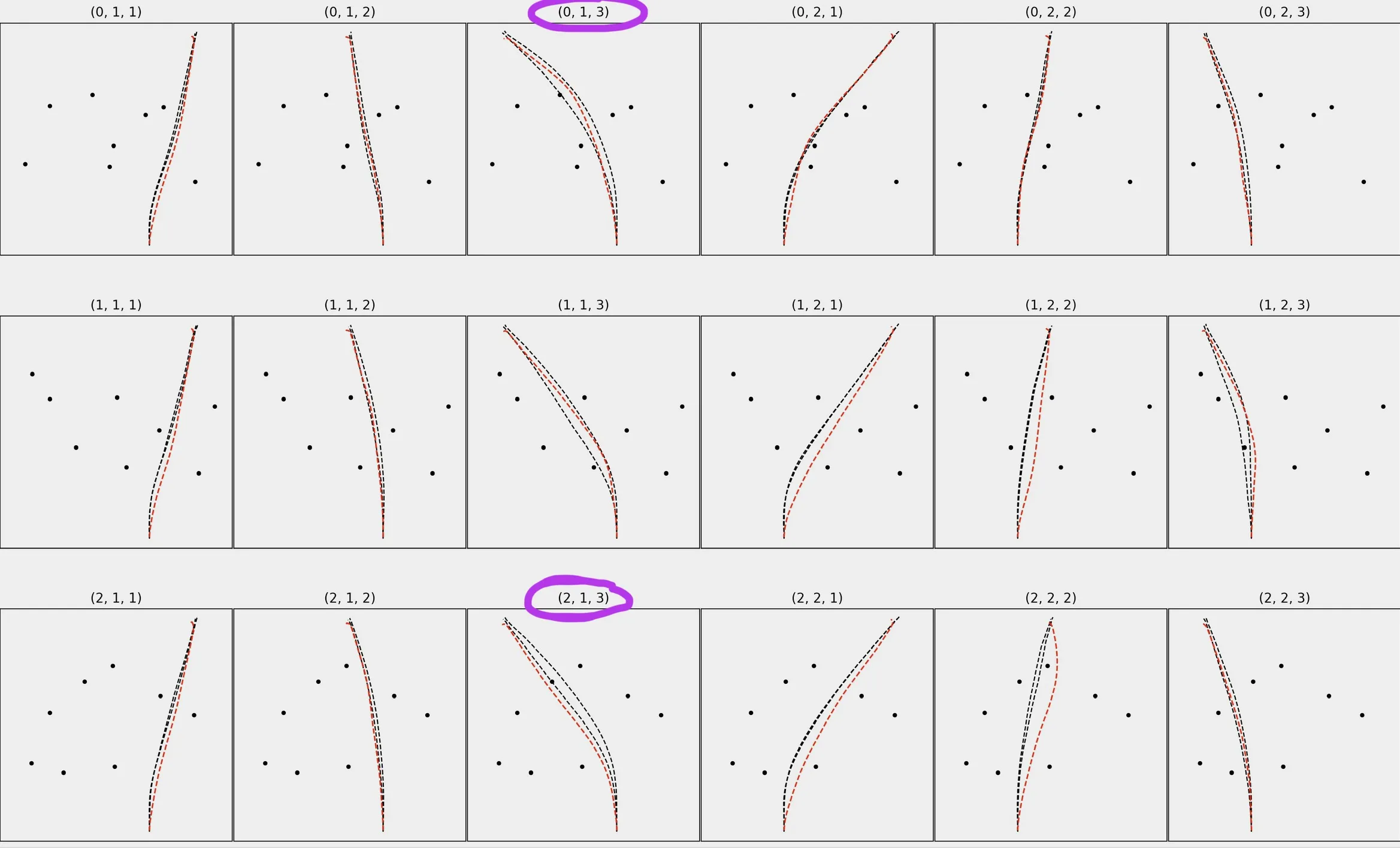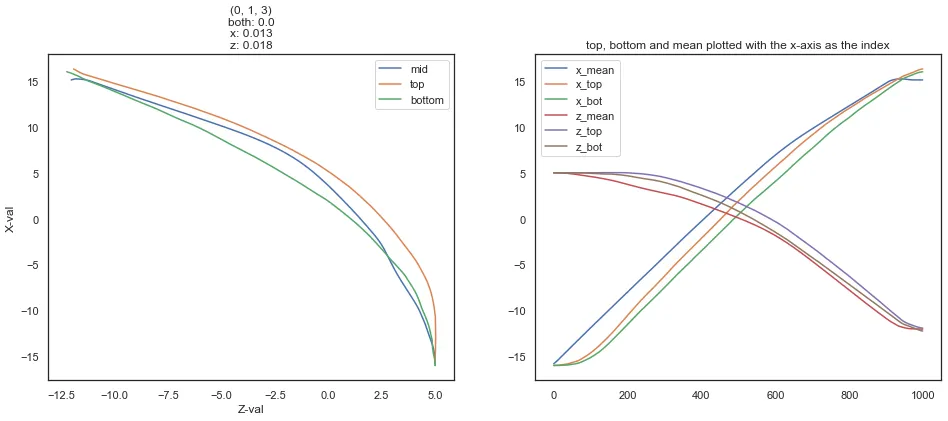df_R包含红色路径的位置数据(在X和Z中)。请注意,X和Z都是位置/空间数据。这些数据没有类似于日期/时间的索引。还要注意,这是来自Unity应用程序的2D数据(由于某种原因,X和Z等效于Y和X)。在两个数据框中,所有路径/轨迹长度均为1000个点。
df_R的预览:
(0, 1, 1)_mean_X (0, 1, 1)_mean_Z ... (2, 2, 3)_mean_X (2, 2, 3)_mean_Z
0 -15.856713 5.002617 ... -15.600160 -5.010470
1 -15.831320 5.003529 ... -15.566172 -5.012251
2 -15.805927 5.004441 ... -15.532184 -5.014032
3 -15.780534 5.005353 ... -15.498196 -5.015814
4 -15.755141 5.006265 ... -15.464208 -5.017595
.. ... ... ... ... ...
95 -12.818362 5.429729 ... -12.391177 -5.391595
96 -12.783905 5.437335 ... -12.357563 -5.396919
97 -12.749456 5.444990 ... -12.323950 -5.402243
98 -12.715017 5.452697 ... -12.290336 -5.407567
99 -12.680594 5.460469 ... -12.256722 -5.412891
df_H包含黑色路径的位置数据,其中包括X和Z的“顶部”和“底部”列,对应于每个图中的两条黑色路径。
df_H的预览:
(0, 1, 1)_top_X (0, 1, 1)_bottom_X ... (2, 2, 3)_top_Z (2, 2, 3)_bottom_Z
0 -16.000000 -16.000000 ... -5.000000 -5.000000
1 -16.000000 -16.000000 ... -5.000000 -5.000000
2 -16.000000 -16.000000 ... -5.000000 -5.000000
3 -16.000000 -16.000000 ... -5.000000 -5.000000
4 -16.000000 -16.000000 ... -5.000000 -5.000000
.. ... ... ... ... ...
95 -15.000971 -15.417215 ... -4.993461 -5.011372
96 -14.979947 -15.402014 ... -4.993399 -5.013007
97 -14.957949 -15.385840 ... -4.993291 -5.014463
98 -14.934171 -15.368649 ... -4.993186 -5.015692
99 -14.908484 -15.349371 ... -4.993069 -5.016940
我需要确认df_R中的X/Z值是否在df_H中的X/Z值范围内。然而,解决方案不能依赖于时间或索引(或逐行比较)。我一直试图实现这个功能,但卡住了。这是我一直在尝试的方法,但它不起作用,因为它依赖于时间。
import pandas as pd
import numpy as np
def CI_analysis(df_H, df_R):
# separate X & Z
df_H_top_X = df_H.filter(regex='top_X')
df_H_bottom_X = df_H.filter(regex='bottom_X')
df_H_top_Z = df_H.filter(regex='top_Z')
df_H_bottom_Z = df_H.filter(regex='bottom_Z')
df_R_X = CI_raycast.filter(regex='mean_X')
df_R_Z = CI_raycast.filter(regex='mean_Z')
# check if X is within the range of top & bottom X
CI_inside_X = pd.DataFrame()
for col in df_R_X:
temp = []
c = 0
for i, val in df_R_X[col].iteritems():
if (val < df_H_top_X.iloc[i,c]) & (val > df_H_bottom_X.iloc[i,c]):
temp.append(1)
else:
temp.append(0)
CI_inside_X[col] = temp
c = c+1
# check if Z is within the range of top & bottom Z
CI_inside_Z = pd.DataFrame()
for col in df_R_Z:
temp = []
# print(col)
c = 0
for i, val in df_R_Z[col].iteritems():
if (val < df_H_top_Z.iloc[i,c]) & (val > df_H_bottom_Z.iloc[i,c]):
temp.append(1)
else:
temp.append(0)
CI_inside_Z[col] = temp
c = c+1
# Check if X & Z were both in-between the top & bottom trajectories
CI_inside = pd.DataFrame()
for col in CI_inside_X:
temp = []
c = 0
for i,row in CI_inside_X[col].iteritems():
if (row == 1) & (CI_inside_Z.iloc[i,c] == 1):
temp.append(1)
else:
temp.append(0)
CI_inside[col] = temp
c = c+1
CI_inside_avg = pd.DataFrame(CI_inside.mean(axis=0)).transpose()
return CI_inside_X, CI_inside_Z, CI_inside, CI_inside_avg
最后,这里是用随机数复制df_R和df_H两个数据框的代码:
df_R_cols = ['(0, 1, 1)_mean_X', '(0, 1, 1)_mean_Z', '(0, 1, 2)_mean_X',
'(0, 1, 2)_mean_Z', '(0, 1, 3)_mean_X', '(0, 1, 3)_mean_Z',
'(0, 2, 1)_mean_X', '(0, 2, 1)_mean_Z', '(0, 2, 2)_mean_X',
'(0, 2, 2)_mean_Z', '(0, 2, 3)_mean_X', '(0, 2, 3)_mean_Z',
'(1, 1, 1)_mean_X', '(1, 1, 1)_mean_Z', '(1, 1, 2)_mean_X',
'(1, 1, 2)_mean_Z', '(1, 1, 3)_mean_X', '(1, 1, 3)_mean_Z',
'(1, 2, 1)_mean_X', '(1, 2, 1)_mean_Z', '(1, 2, 2)_mean_X',
'(1, 2, 2)_mean_Z', '(1, 2, 3)_mean_X', '(1, 2, 3)_mean_Z',
'(2, 1, 1)_mean_X', '(2, 1, 1)_mean_Z', '(2, 1, 2)_mean_X',
'(2, 1, 2)_mean_Z', '(2, 1, 3)_mean_X', '(2, 1, 3)_mean_Z',
'(2, 2, 1)_mean_X', '(2, 2, 1)_mean_Z', '(2, 2, 2)_mean_X',
'(2, 2, 2)_mean_Z', '(2, 2, 3)_mean_X', '(2, 2, 3)_mean_Z']
df_H_cols = ['(0, 1, 1)_top_X', '(0, 1, 1)_bottom_X', '(0, 1, 1)_top_Z',
'(0, 1, 1)_bottom_Z', '(0, 1, 2)_top_X', '(0, 1, 2)_bottom_X',
'(0, 1, 2)_top_Z', '(0, 1, 2)_bottom_Z', '(0, 1, 3)_top_X',
'(0, 1, 3)_bottom_X', '(0, 1, 3)_top_Z', '(0, 1, 3)_bottom_Z',
'(0, 2, 1)_top_X', '(0, 2, 1)_bottom_X', '(0, 2, 1)_top_Z',
'(0, 2, 1)_bottom_Z', '(0, 2, 2)_top_X', '(0, 2, 2)_bottom_X',
'(0, 2, 2)_top_Z', '(0, 2, 2)_bottom_Z', '(0, 2, 3)_top_X',
'(0, 2, 3)_bottom_X', '(0, 2, 3)_top_Z', '(0, 2, 3)_bottom_Z',
'(1, 1, 1)_top_X', '(1, 1, 1)_bottom_X', '(1, 1, 1)_top_Z',
'(1, 1, 1)_bottom_Z', '(1, 1, 2)_top_X', '(1, 1, 2)_bottom_X',
'(1, 1, 2)_top_Z', '(1, 1, 2)_bottom_Z', '(1, 1, 3)_top_X',
'(1, 1, 3)_bottom_X', '(1, 1, 3)_top_Z', '(1, 1, 3)_bottom_Z',
'(1, 2, 1)_top_X', '(1, 2, 1)_bottom_X', '(1, 2, 1)_top_Z',
'(1, 2, 1)_bottom_Z', '(1, 2, 2)_top_X', '(1, 2, 2)_bottom_X',
'(1, 2, 2)_top_Z', '(1, 2, 2)_bottom_Z', '(1, 2, 3)_top_X',
'(1, 2, 3)_bottom_X', '(1, 2, 3)_top_Z', '(1, 2, 3)_bottom_Z',
'(2, 1, 1)_top_X', '(2, 1, 1)_bottom_X', '(2, 1, 1)_top_Z',
'(2, 1, 1)_bottom_Z', '(2, 1, 2)_top_X', '(2, 1, 2)_bottom_X',
'(2, 1, 2)_top_Z', '(2, 1, 2)_bottom_Z', '(2, 1, 3)_top_X',
'(2, 1, 3)_bottom_X', '(2, 1, 3)_top_Z', '(2, 1, 3)_bottom_Z',
'(2, 2, 1)_top_X', '(2, 2, 1)_bottom_X', '(2, 2, 1)_top_Z',
'(2, 2, 1)_bottom_Z', '(2, 2, 2)_top_X', '(2, 2, 2)_bottom_X',
'(2, 2, 2)_top_Z', '(2, 2, 2)_bottom_Z', '(2, 2, 3)_top_X',
'(2, 2, 3)_bottom_X', '(2, 2, 3)_top_Z', '(2, 2, 3)_bottom_Z']
df_R = pd.DataFrame(np.random.randint(0,100,size=(1000, 36)), columns=df_R_cols)
df_H = pd.DataFrame(np.random.randint(0,100,size=(1000, 72)), columns=df_H_cols)


x_black1 <= x_Red <= x_black2的行数/总桶数。如果您的所有Y值已对齐,则应该不难做到这一点?最好在pandas datatrames之外完成此操作。 - Tommy[(x_b1, x_r, x_b2),....],其中每个3元组都是为相同的Y值而设计的;然后计算比率。例如:读取您的数据帧并将它们转储到这个桶结构中。 - Tommyfloor(Yval / bucket_size)或类似的内容。 - Tommy